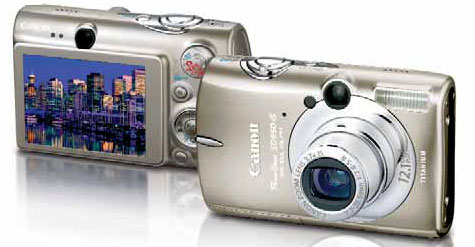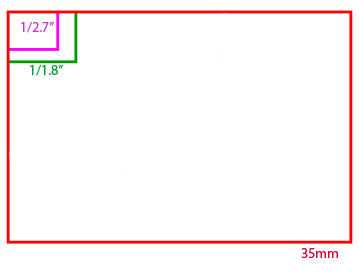The Digital Sensor: A Guide to Understanding Digital Cameras
by Wesley Fink on April 21, 2008 1:00 AM EST- Posted in
- Digital Camera
A few years ago, all digital cameras were "point and shoot" and they were very expensive compared to film cameras. Digital prices dropped rather quickly as digital sensor resolution continued to increase. Soon enough digital "point-and-shoot" cameras were available at every price point from a basic snapshot to the more serious models geared at the prosumer market.
At the dawn of the consumer digital SLR in 1999, a 2.7MP (megapixel) DSLR with an APS C sensor was considered an incredible buy at $5000. Tremendous growth in market share and the falling prices of DSLR cameras in the years since have created new buying options for those shopping for an upgrade to an existing camera or even a first camera. This has been particularly true in the last couple of years. All of the old reasons to own a point and shoot instead - with lower cost leading the way - have fallen by the wayside as the DSLR has continued to evolve and become both very price competitive with P&S and much easier to use.
However, many new DSLR buyers are walking into a brave new world with blinders on. The first question everyone should ask is why should you buy a DSLR instead of a point and shoot? Are there real technical advantages to DSLRs? After all the ads for point-and-shoots are hyping the same range of sensor resolutions that you will find in digital SLR cameras, so why buy a DSLR? The answer to that question is what really prompted this article.

Yes, you can buy 10MP and 12MP point-and-shoot cameras - the same megapixel range as current mainstream DLSR cameras - but they cannot possibly produce the same image quality over the same wide range of shooting conditions as a digital SLR. The reason why is simple physics, as the point-and-shoot sensors are much smaller than sensors in a DSLR. In fact, that is also the very reason why point-and-shoot digital cameras were the only choices in the market for a few years.
The early sensors were much lower megapixel resolutions, far too low to begin to compete with film photography. Photo hobbyists saw few advantages in moving to a low resolution system since the reason they used an SLR was high image quality. It wasn't until resolutions reached the 2-4MP range that there was any interest in a digital SLR.

The early sensors were also very small, developed primarily for video usage. The 1/2.7" compact sensor is 5.3x4.0mm and the larger 1/1.8" is 7.2x5.3mm - compared to 35mm at 24x36mm. These typical compact sensors are just a tiny fraction the size of 35mm sensors, and these sensors were among the largest available in P&S digital cameras. Some tried to develop proprietary systems based on a smaller sensor size with more compact lenses, but nothing caught on in the industry. The cost of early sensors was also astronomical, making the early digital SLR cameras only useful for production, high volume photography where the cost could be justified.
Finally, early digital development saw sensor resolution and size in constant evolution. With sensor size changing with each new generation, it was much easier to design a point-and-shoot camera around each new sensor generation using a dedicated and non-interchangeable lens. Until sensor size stabilized, a digital SLR that used either existing 35mm lens systems or a new "standard size" was not practical.










72 Comments
View All Comments
andrewln - Monday, April 21, 2008 - link
This was followed in about 6 months by the introduction of the Samsung 14.6MP CMOS sensor in the Pentax D20.should be Pentax K20D
Wesley Fink - Monday, April 21, 2008 - link
Typo corrected. Unfortunately spell check can't catch model numbers that are misstated.araczynski - Monday, April 21, 2008 - link
now i know what pc tech illiterate people feel like :)its a good thing i don't care about photography, interesting read none the less.
finbarqs - Monday, April 21, 2008 - link
the thing is, I've read the reviews and saw the comparisons between the 5D and the D200 (I believe that was the last CCD sensor that Nikon used). The 5D has way better per-pixel sharpness than the D200. Perhaps the technology of the CMOS made it so it finally "looks" better than the CCD. Or at least on the Canon side of things. I'm not biased towards any camera. I've own an XTi, 5D, Panasonic DMC-L1, and now a D300. I'm hoping to own the next 5D MKII (or whatever they call it).Even the D2X used a CMOS sensor, and I thought Nikon made the D300 sensor, as well as the D3 sensor (FF). What I also find "funny" is that Sony doesn't have a FF sensor yet, but nikon does, thus leaving me to believe that Nikon came up with their own FF sensor.
melgross - Monday, April 21, 2008 - link
It's Nikon's own design, though I don't remember who makes it.haplo602 - Monday, April 21, 2008 - link
Nice article Wesley, finaly one Anandtech photo related article I enjoyed reading.On note on the growing megapixel count. Sooner more than later, DSLR in APS-C (and later full frame ones) will hit the same technology wall P&S are facing (too small photosite).
This is one factor that makes me a happy film shooter :-) I know that my limit is the scanner up to around 10MP and I have less flexibility in shooting conditions (either 2 bodies or limited by ISO and film type), in every other situation I am equal or better off.
I am waiting for an affordable Nikon full frame body and then I will make my switch to digital (but that is yet years to come).
wally626 - Monday, April 21, 2008 - link
A sensor technology improves APS-C will be able to go to high enough pixel counts and have very good quality. For most consumers some where around 12 MP is enough, if the sensors improve to where this can hit 3200 ISO with low noise 99 percent of the market would be satisfied.The full frame bodies will replace the medium formats of the film world. There have been some really good medium format cameras that take much better images than 35mm but very few are sold. I think the article is correct in saying the full-frame DSLR will be the PRO cameras and priced as such.
melgross - Monday, April 21, 2008 - link
The number ofpixels is directly related to the print size.If you go by the oft quoted 300 dpi on the final print for maximum quality, you will need a sensor with 2400 x 3600 resolution for a full frame 8 x 12 print, or 8.64 MP. For an 8 x 10, it would be 7.2 MP (4/3 sensor).
For a larger 11 x 17, it would be 3300 x 5100, or 16.83 MP, or 13.86 for the 11 x 14 4/3 sensor print.
You can figure the rest of the sizes my multiplying the inch size of the print edges L x W by 300 to come up with a number.
But the truth is that 240 dpi is going to be good enough fot most prints, and youcan do the numbers that way.
When you know the numbers, you can figure out what size sensor you will need for the highest quality work.
But for most people, even 180 dpi will be enough for their prints. Going to that gives more flexibility, as the sensor pixel count is much smaller.
It's better to get a camera with a longer OPTICAL zoom rather than to go for the biggest number of sensor pixels.
haplo602 - Tuesday, April 22, 2008 - link
^ this ^It's all a matter of print size. I am an amateur/hobbyist, and anything past A4 is large for me. I have printed reasonable quality 8x12 prints from a consumer slide film and home film scanner.
I can hang them up on the wall in a nice frame and they will serve their purpose :-)
Idealy I'd need a 12-14MP full frame Nikon with goot ISO/Noise characteristics (f.e. D3) and it will satisfy my needs for years to come.
Heidfirst - Monday, April 21, 2008 - link
especially as I was wondering the other day what smaller process technology would do for digital sensors?Normally of course smaller process means cooler & more importantly smaller>cheaper to make but of course with sensors you are talking a fixed size so not any cheaper.
But would the potential increased precision of circuitry mean any better image quality?
& a little nitpicking:
Sony didn't buy Konica Minolta (which continues in business) but certain assets from the Photo Imaging division of KM. As to what that actually means there is little hard knowledge outside the 2 companies as it seems that KM still retain some IP & indeed a shareholding in some of the production facilities.
Also, current thinking seems to be that the "A900" may not be called that but something else to differentiate it from the APS-C models.